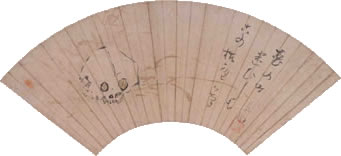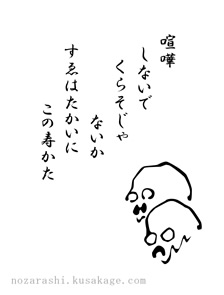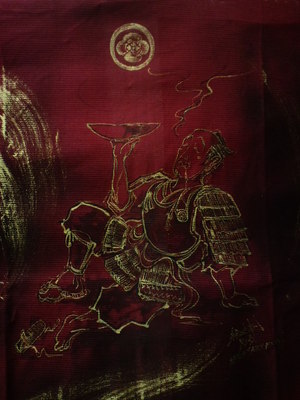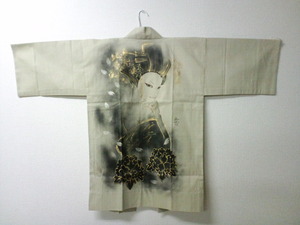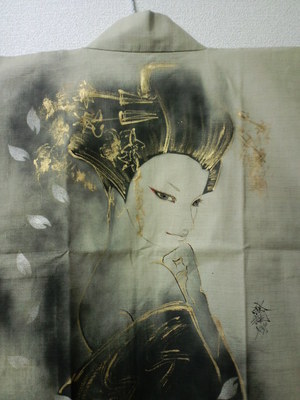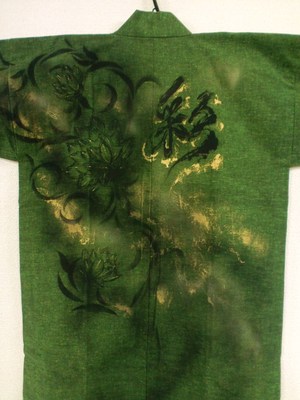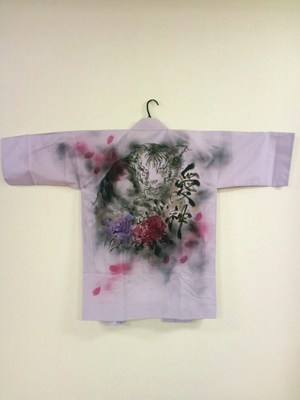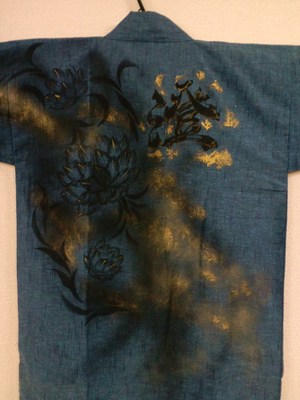Sunday, Jan. 31, 2010
Few writers have been able to evoke the bare beams of poverty or the lambent lives of those who endure it with more dignity than Fumiko Hayashi (1903-1951).
 |
| Spotless reputations: Wataru Shimizu (left) and Yukio Kato are expert professionals in the specialist field of shimi-nuki (stain removal from kimono and delicate fabrics). |
 |
It therefore seems fitting that I pick the iciest day of winter to walk northwest of Nakai Station (on both the Seibu Shinjuku and Oedo lines in Shinjuku Ward) in search of the home of this feminist author who ousted penury with a pen.
I find a sign pointing uphill to the Hayashi Fumiko Memorial Hall, and I worry it will be a dank concrete place full of musty books in locked glass cases. At nearby garden cafe Ra-Ra-Ra, I chat with 65-year-old owner Mitsue Maezawa, who tells me, "I opened my business when my grandchildren were grown. I was inspired by Hayashi's independence."
Maezawa also assures me that the home where Hayashi lived the last 10 years of her short life, from 1941-51, is well worth visiting. Climbing Yon-no-saka (Fourth Slope), I see that she's right. Tucked behind the remains of the bamboo grove that Hayashi loved, a sukiya-tsukuri (refined, tea house-inspired) home seamlessly incorporates features considered modern for 1941, such as a large kitchen and small reception parlor — elements that Hayashi and her architect, Bunya Yamaguchi, designed together.
Building-size restrictions back then meant that Hayashi had to split the residence into what amounts to two houses — one for guests and editorial meetings, the other for her husband, painter Tezuka Ryokubin, their adopted son, Tai, and for writing.
A child of itinerant peddlers and no stranger to poverty or abusive love affairs, Hayashi nonetheless gambled on success, exhausting her savings to buy this land in Nakai. Proceeds from two of her most famous works, "Yukigumo" ("Floating Clouds") and "Horoki" ("A Vagabond's Diary"), then helped cover the building costs.
As I walk the garden, a grounds attendant takes my arm and shows me a purple-tinted yukiwariso ("snow- breaking" hepatica) surrounded by glittering needles of column frost. With plum buds still tight, and the garden mostly dormant, this is an unexpected gift.
Circling the estate, I peer into the rooms of the houses, so open-aired that clouds and bees could waft through unobstructed. But I'm looking for the place where Hayashi actually wrote.
I know it when I see it; it is the storage room in the family wing where she set up her desk. Shielded from the bright winter sun, insulated by closets, the garden view adjustable with horizontally sliding shoji (paper screens) and a teapot poised on a wooden hibachi: here is a room in which imagination could pace.
I linger on the grounds a bit longer before retracing my steps across the Myoshoji River and then heading east beside its bank. I spot homes, some not 2 meters wide, clinging to the top of its floodwalls, and I wonder who lives in such confines. At a garage, where I think to ask this question, I meet 60-year-old Takashi Otani, who is sedulously snipping a complicated curve from sheet metal.
"Curves are the most difficult to execute," Otani tells me, explaining that he's "constructing a roof decoration for Disney, for the 'Hungry Bear' attraction."
Otani has been working in bankin (sheet metal) for 40 years, and is now part of the team doing renovations on the amusement park. "Tokyo Disneyland is 26 years old," he says while leafing through a book of complex specifications, "so it's time."
I discover that Otani lives above his garage workshop, but before I can delve further, he realizes I'm interested in people who work with their hands. He promptly drags me off to meet a friend of his.
 |
| Learning curves: Master dyer Masaru Ono gives quiet pointers to Chikako Okano, one of the apprentices at Futaba-en, as they stretch out lengths of fabric to dry. |
Back across the river I go, as Otani explains that this stretch of the Myoshoji used to be full of dyers washing out their fabrics in the clear-running waters. And where there are dyers, there are kimono, and where there are kimono, Otani tells me, there are men engaged in shimi-nuki (stain removal). But as I am about to learn, this is a whole artisan's craft unto itself.
Yukio Kato is busy repotting plants when we arrive. Otani orders his former school classmate to brush off the dirt and hurry up to show me what shimi-nuki is all about. Kato, extremely good-natured through his puzzlement, immediately complies. He leaps over his low worktable, turns on a gas stove, and spreads out a few kimono and obi fabrics.
As he arranges bottles of bleach, benzene, and "trade-secret" chemical concoctions for stain removal, he and Otani trade banter. I note that some of the solvents Kato is using are toxic. "I don't care," he says. "I'm an idiot, so I became a craftsman. You can tell everyone that."
"Speak for yourself," Otani retorts, turning to me. "We craftsmen actually use our heads, you know."
Kato roars in laughter at this, but as soon as he starts to work, he's utter diligence. Taking a forged spatula-like tool off the gas stove, he quenches it briefly in water, then slides it into the sleeve of a kimono. The heat from the tool, a kote, steams chemicals he has applied to a stain, evaporating both simultaneously and leaving the delicate kimono spotless. Sonically pulsed water and electromagnetic guns may be some of the newer tools of his trade, but where colors have faded, Kato can even spot-dye a kimono the age-old way.
Removing sweat marks or stains left too long, and cleaning fabrics dyed a shade known as "Fuji pink" are the biggest challenges, Kato explains, scrubbing at a stubborn mark with a horsetail brush. When he unscrews an ammonia-based cleanser, it propels me and Otani to our feet and half out the door.
Thanking Kato from a safe distance, we cross the river once again and I follow Otani's directions to one of Tokyo's last dyeing factories, Futaba-en. I tell him I will stop in again soon. He shakes his head as he quips, "Look for me at Disneyland."
The side yards of humble houses on the way to Futaba-en, many piled high with abandoned electrical goods and junk, conjure up Hayashi's "Horoki," in which the narrator bemoans not having enough yen to buy benzene to clean her own kimono.
In stark contrast to these surroundings, Futaba-en's sleek new facilities come as a surprise. From a video display outside the building, I get a quick education in two dye styles.
Edo Komon, a stenciled resist-dye technique, results in teeny, intricate patterns originally designed to sneak by restrictions placed on luxury clothing in the Edo Period (1603-1867) by the simple expedient of appearing to be one plain color from a few meters away.
Edo Sarasa, Tokyo's take on pattern dyeing, was derived from techniques in India and Java and requires as many as 30 or 40 individual stencils to complete the pattern.
 |
| Cultural cache: Originally intended as a storage space, the room in her home that feminist writer Fumiko Hayashi chose as her workplace has a quiet simplicity conducive to conjuring the trials of Japan's underclasses in the first half of the 20th century. The house, now the Hayashi Fumiko Memorial Hall, is a marvelous 1940s time capsule set in grounds that would be any garden-lover's delight. |
Motobumi Kobayashi, the fourth-generation owner of Futaba-en, has pumped fresh color into the world of traditional dyeing by attracting young and motivated apprentices, developing new products made from the fabrics, and showcasing his artistic wares internationally. In fact, I barely get a chance to speak to him before he takes his leave for an exhibition in Paris.
Instead, over Futaba-en's "Milky Way" of drying kimono lengths, I meet 66-year-old Masaru Ono, who has more than 48 years' experience in dyeing techniques. Two apprentices, Chikako Okano, 30, and Yuji Morimoto, 27, work ceaselessly in the background as Ono describes how the correct spacing of the thin shinshi (bamboo struts) that hold the fabric taut while dyeing is one of the trickiest skills to teach.
"But it's all hard," he says with a knowing smile, "learning the process, sequencing, and speed."
To share his skills, though, Ono teaches classes to the public on Fridays and Saturdays in the hope that others, too, will discover the aji (nuance) of genuine dyed work.
The day draws to a close, but Ono insists that I meet yet another shimi-nuki expert, Wataru Shimizu. Sun glints like gold foil on the river as I cross it yet again. In a third-story workshop with no sign outside — those who need to know where Shimizu is, already know — the 58-year-old expert quietly works on a kimono that to me appears perfect. But, no. He points out a bit of color that has bled where it shouldn't. He eyes it with a loupe. Yes, he will need to fix that. He takes a matchstick, soaks it in a solvent and, using his fingernail as a guide, drums the infinitesimal flaw out of existence.
As he works, Shimizu explains that the sound a kote makes when dipped in water lets him know if it will bake the kimono or not. Shimizu learned the trade from his father, who studied in Kyoto.
I ask if Shimizu knows Kato, who also employs a kote. He smiles. "Kato is the apprentice of one of my apprentices," he says, with pride.
Shimizu's wife quietly receives delivery men who come and go with boxes of kimono as we talk. When I finally head home, I muse that along this drab backstreet live some of the most enriching people in the city.
